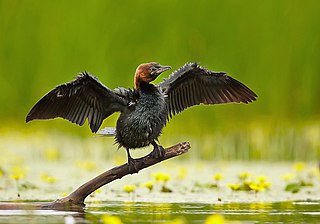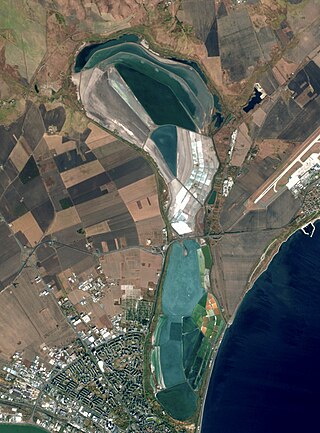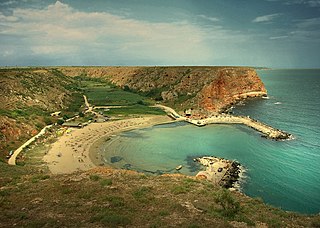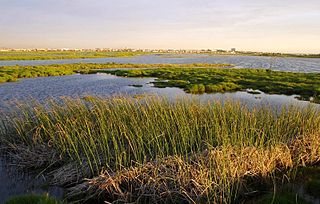
The pygmy cormorant is a member of the Phalacrocoracidae (cormorant) family of seabirds. It breeds in south-eastern Europe and south-western Asia. It is partially migratory, with northern populations wintering further south, mostly within its breeding range. It is a rare migrant to western Europe.

Lake Uluabat is the name of a freshwater lake in the vicinity of Bursa, Turkey. It is a large lake, covering an area of between 135 and 160 km2 depending on the water level, but very shallow, being only 3 m deep at its deepest point. The lake contains eight islands and one other that is sometimes an island and sometimes a peninsula. The largest island is known as Halilbey Island. In the southwest the lake is fed by the Mustafakemalpaşa River, which has formed a silty delta. Water leaves the lake by way of the Ulubat stream, flowing to the west, and reaches the Sea of Marmara via the Susurluk River.

The Srebarna Nature Reserve is a nature reserve in northeastern Bulgaria, near the village of the same name, 18 kilometers (11 mi) west of Silistra and two kilometers (1.2 mi) south of the Danube. It comprises Lake Srebarna and its surroundings and is an important wetland located on the Via Pontica, a bird migration route between Europe and Africa. As a result, it provides nesting and migratory habitat for many endangered bird species.

The Towra Point Nature Reserve is a protected nature reserve that is located in Sutherland Shire, Southern Sydney, New South Wales, in eastern Australia. The 603-hectare (1,490-acre) reserve is situated on the southern shores of Botany Bay at Kurnell, within the Sutherland Shire. The reserve is protected under the Ramsar Convention as a wetland of international importance as an important breeding ground for many vulnerable, protected, or endangered species. The Towra Point Aquatic Nature Reserve is located in the surrounding waterways.

Keenjhar Lake, commonly called Kalri Lake, is located in Thatta District of Sindh the province of Pakistan. It is situated about 36 kilometres (22 mi) from the city of Thatta. It is an important source of drinking water for Thatta District and Karachi city. Through the construction of a bund on the eastern side, it is said that the lake was formed by the union of two lakes: Sonehri and Keenjhar.

Lake Atanasovsko or Lake Atanasovo is a salt coastal lake north of Burgas, Bulgaria, located in direct proximity to the Black Sea. The lake is about 5 km long and divided in two by a strip of sand in the middle. The lake is particularly known for the diversity of its flora and fauna and is surrounded by swamps and canals that drain the whole local basin into the sea.

Lake Mandrensko or Lake Mandra is the southernmost of the Burgas Lakes, located in the immediate proximity of the Black Sea and close to Burgas. Being 8 km long and 1.3 km wide at maximum, as well as having an area of 38.84 km², it was a brackish natural lake until 1963, when it was turned into a reservoir with the construction of a dam to secure fresh water for the large Neftochim Burgas oil refinery. The rivers Izvorska, Fakiyska, Sredetska and Rusokastrenska flow into the lake.
The Burgas Lakes or Burgas Wetlands are a group of coastal lakes of varying saltiness located around the Bulgarian city of Burgas in the proximity of the Black Sea. They constitute the largest group of lakes in the country and comprise some of Bulgaria's biggest and most important lakes.

Hutovo Blato is a nature reserve and bird reserve located in Bosnia and Herzegovina. It is primarily composed of marshlands that were created by the underground aquifer system of the Krupa River. It is fed from the limestone massif of Ostrvo that divides the Deransko Lake and Svitavsko Lake. The reserve is on the list of BirdLife International's Important Bird Areas. It is the largest reserve of its kind in the region, in terms of both size and diversity. It is home to over 240 types of migratory birds and dozens that make their permanent home in the sub-Mediterranean wetlands surrounding Deransko Lake. In the migration season, tens of thousands of birds fill the lake and its surroundings.

Vedanthangal Bird Sanctuary is a 30-hectare (74-acre) protected area located in the Madurantakam taluk of the Chengalpattu District in the state of Tamil Nadu, India. The sanctuary is about 75 kilometres (47 mi) from Chennai on National Highway 45 ([NH45]). It is easily reachable from Madurantakam and Chengalpattu. More than 40,000 birds, from various parts of the world visit the sanctuary during the migratory season every year. Vedanthangal is home to migratory birds such as pintail, garganey, grey wagtail, blue-winged teal, common sandpiper and the like. It has been designated as a protected Ramsar site since 2022.

The Suchindram Theroor Vembannur Wetland Complex is a protected area comprising the Suchindram Kulam wetlands at 8°7′30″N77°27′30″E, and the Theroor Kulam wetlands at 8°10′45″N77°27′45″E, and the Vembannur Wetland Complex, all near Suchindram town in Kanyakumari District, Tamil Nadu, India. It is located between Nagercoil and Kanyakumari on the National Highway No. 47. Being at the extreme southern tip of India, this area underlies the southernmost continental range of the Central Asian Flyway. Constitution of this new wildlife sanctuary was proposed in 2002 and remains under consideration of the Government. International name is Suchindram Therur, Vembanoor, Important bird area code no. IN279, criteria: A1, A4i. Parts of the sanctuary have been designated as protected Ramsar sites since 2022.

The Central Asian Flyway (CAF), Central Asian-Indian Flyway, or Central Asian-South Asian Flyway is a flyway covering a large continental area of Eurasia between the Arctic Ocean and the Indian Ocean and the associated island chains. The CAF comprises several important migration routes of waterbirds, most of which extend from the northernmost breeding grounds in Siberia to the southernmost non-breeding wintering grounds in West Asia, India, the Maldives and the British Indian Ocean Territory.

Marievale Bird Sanctuary is a protected area in Gauteng, South Africa. It is about 15 km2 in size, and situated on the East Rand on the southern half of the Blesbokspruit wetland, a Ramsar site. The Blesbokspruit is a major perennial river in Gauteng which is flanked by extensive floodplains on either side. Nearby is the Suikerbosrand Nature Reserve.

Bolata is a small cove and Nature reserve located in the Northern Bulgarian Black Sea Coast.

The Rietvlei Wetland Reserve is a 663-hectare (1,640-acre) nature reserve situated in Table View, Western Cape, South Africa. It is managed by the City of Cape Town's Environmental Resource Management Department.

Housing more than 200 resident and wintering bird species, Chennai has long been a haven for bird watchers. It is the one of the few urban areas in India with diverse range of birds including greater flamingo, black baza, osprey, Indian eagle-owl, Coppersmith barbet, Spot billed pelican and pied avocet can be seen. The following are some known birding hotspots in and around Chennai.

Thale Noi Non-Hunting Area is a protected fresh water wetland located in Phatthalung province, southern Thailand. Covering an area of 460 km2, the wetlands are situated approximately 20 km inland from the east coast peninsula of the Gulf of Thailand and 115 km north of the Malaysian border in Satun province. Thale Noi Non-Hunting Area is one of the largest natural freshwater lakes in South East Asia. It is the smallest, northernmost basin in the chain of lagoons that form Songkhla Lake, spreading across three provincial boundaries into Nakhon Si Thammarat, Phatthalung and Songkhla provinces and is home to the critically endangered Irrawaddy dolphin.

Samaguri Beel is a ox-bow shaped (U-shaped) wetland and lake located near to Nagaon of Nagaon district in Assam. This Beel is situated in the Brahmaputra river basin. This lake is formed by the abandoned path of the Kolong River.

Kuşcenneti National Park, established on 31 August 1959, is a national park located northeast of the Lake Kuş in Bandırma district of Balıkesir Province, northwestern Turkey.




















